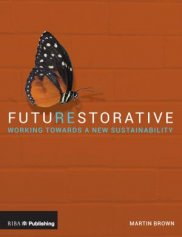Main author
Michael BrooksFutuREstorative - review
Martin Brown – ‘FutuREstorative: Working towards a new sustainability’
Published by RIBA Publishing (2016)
FutuREstorative: Working towards a new sustainability, written by the consultant Martin Brown, is a worthy addition to the growing corpus of texts debating the problems and solutions facing the built environment and sustainability.
Where this book differs somewhat is in its inclusion of blog-style contributions from a collection of business leaders, advocates and practitioners, from construction and beyond.
Running through the book is the idea that respect and intolerance for causing damage to nature has been lost, as the built environment has gradually eroded our real connection to nature. Key to the book’s theme is the idea of shifting the sustainability debate from focusing simply on energy performance on to a more holistic view of social performance, wellness, health and healthy buildings.
The book posits the concept of ‘net-positive construction’, which asks the question ‘what if every construction site made the world a better place?’; that, instead of being wasteful and emissions-heavy, the construction sector could generate more energy, water and reusable resources than it consumes.
The concepts and benefits of biophilia and biomimicry are explored as methods of learning from and adapting natural processes. It makes the case that best practice and established sustainability standards have all-too-often fallen into the box-ticking ‘doing less bad’ trap, rather than aiming to do good. Innovations such as BIM, the internet of things and social media are seen as new tools in the ‘sustainability toolbox’, providing opportunities to advance the development of, and action on sustainability.
While some may come away frustrated with the solutions on offer, the book serves as a challenge to the limited orthodoxies of contemporary thinking rather than attempting to provide a prescriptive road-map to definite answers.
Students, practitioners and policy makers in the built environment would do well to engage with the challenges and ideas raised by this book, as it is this kind of creative and forward thinking response that will be essential in adapting the built environment to prevent and respond to the uncertainties of climate change.
[edit] Related articles on Designing Buildings
- An Introduction to Passive House - review.
- Better Buildings: Learning from buildings in use - review.
- Bill Gething and Katie Puckett - Design for Climate Change.
- Biomimicry in Architecture - review.
- Building Revolutions - review.
- Climate change science.
- Ecological impact assessment.
- Environmental policy.
- Green building.
- How Buildings Work - review.
- Retrofit.
- Sustainability.
Featured articles and news
Latest Build UK Building Safety Regime explainer published
Key elements in one short, now updated document.
UKGBC launch the UK Climate Resilience Roadmap
First guidance of its kind on direct climate impacts for the built environment and how it can adapt.
CLC Health, Safety and Wellbeing Strategy 2025
Launched by the Minister for Industry to look at fatalities on site, improving mental health and other issues.
One of the most impressive Victorian architects. Book review.
Common Assessment Standard now with building safety
New CAS update now includes mandatory building safety questions.
RTPI leader to become new CIOB Chief Executive Officer
Dr Victoria Hills MRTPI, FICE to take over after Caroline Gumble’s departure.
Social and affordable housing, a long term plan for delivery
The “Delivering a Decade of Renewal for Social and Affordable Housing” strategy sets out future path.
A change to adoptive architecture
Effects of global weather warming on architectural detailing, material choice and human interaction.
The proposed publicly owned and backed subsidiary of Homes England, to facilitate new homes.
How big is the problem and what can we do to mitigate the effects?
Overheating guidance and tools for building designers
A number of cool guides to help with the heat.
The UK's Modern Industrial Strategy: A 10 year plan
Previous consultation criticism, current key elements and general support with some persisting reservations.
Building Safety Regulator reforms
New roles, new staff and a new fast track service pave the way for a single construction regulator.
Architectural Technologist CPDs and Communications
CIAT CPD… and how you can do it!
Cooling centres and cool spaces
Managing extreme heat in cities by directing the public to places for heat stress relief and water sources.
Winter gardens: A brief history and warm variations
Extending the season with glass in different forms and terms.
Restoring Great Yarmouth's Winter Gardens
Transforming one of the least sustainable constructions imaginable.
























